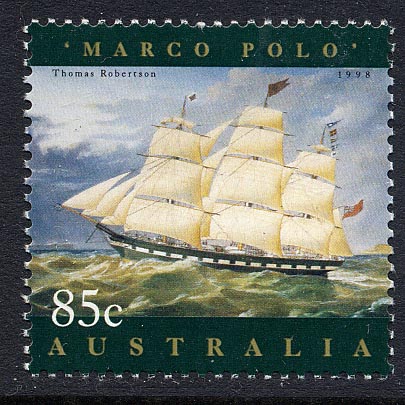Post
by aukepalmhof » Mon Mar 08, 2010 8:54 pm
The MARCO POLO was a three-masted clipper ship built of wood by James Smith on the Marsh Creek, near Saint John, New Brunswick, for account of the yard.
When still on the stock she was destroyed by a heavy gale, but she was rebuilt.
17 April 1851 launched as the MARCO POLO. The launching was also not without problems, first the vessel did not want to leave the slipway, and when she was gliding, she got so much speed that she grounded on the opposite side of the Marsh Creek. Beneaped by the stern and the bow still in deep water it took a fortnight, and only with the help of a harbor tug SEA LION from Saint John was it possible to refloat the MARCO POLO. But when refloated she was hogged.
Ship rigged.
Tonnage 1,625 gross tons, dim. 184.1 x 36.3 x 29.4ft.
Her maiden voyage under command of Capt. William Thomas was with a cargo of timber for Liverpool, the passage she made in 15 days.
Then a trip to Mobile, USA and a return voyage loaded with cotton in 35 days to Liverpool.
After discharging, she was anchored in the Mersey and was up for sale.
1852 Sold to Paddy McGee at Liverpool, in June the same year bought by James Baines, the owner of the famous Black Ball Line.
She was refitted in an emigrant ship for the service to9 Australia (Goldrush) and her hull underwater was also copper sheated.
04 July 1852 she sailed from the U.K. with a crew of 60 men and under command of Capt. James Nichol Forbes, better known as Bully Forbes. Arrived after a passage of 76 days on 18 September at Melbourne.
After arrival the crew was arrested for insubordination by the police. Capt. Forbes was afraid his crew would desert and walk away to the gold fields in Australia. Just before sailing the crew was brought back on board by the police.
On her return voyage to the U.K. she easily made 316/318 mile a day, one day she did make 353 miles. Arrived 26 December on Boxing Day at the Mersey, her owner did not believe first that the vessel had arrived. She did make the passage in 76 days; it was the first recorded roundtrip in less than six months.
13 March she left again from Liverpool for Melbourne where she after a passage of 75 days arrived.
1854 Command was taken over by her first mate Charles MacDonald, and he did even better, he sailed in 72 days from Liverpool to Melbourne.
August 1858 she rescued the passengers and crew of the emigrant vessel EASTERN CITY which had burnt at sea off Cape of Good Hope.
07 March 1861 she collided with an iceberg south of Cape Horn, she arrived Valparaiso on 2 May badly leaking, she left on 22 May after repair bound for Liverpool where she arrived after a passage of 183 days from Melbourne.
1867 She failed to pass the passenger survey, and was put in the general cargo trade.
1871 Sold to J.Wilson & Blain, South Shields, and used in the coal and timber trade.
1874 Her rig was reduced to barque.
1881 was she sold to Bell & Lawes at South Shields. Used in the guano trade from ports in Chile to northern Europe.
1882 Sold to Capt. Bull at Christiania (Oslo), Norway, mostly used in the timber trade between Canada to Europe.
27 June 1883 got on fire at the ballast grounds (the anchorage where the ballast was dumped overboard before loading) at Quebec, but the fire was quickly extinguished before much damage was done.
Thereafter she loaded a cargo of timber at Quebec City with destination Europe.
19 July 1883 she left with good weather, but encountered in the Gulf of St Lawrence stormy weather.
The now old MARCO POLO with rotten timbers and frames burst her seams open on 22 July and water was pouring in much quicker than the crew could pump it out. When the weather improved the only thing Capt. Bull could do, was to beach the vessel under full sail and heading for the rocky beach. When hitting the rocks on a beach at Cavendish the mast with a lot of noise were coming down. The crew was saved, they could walk via the bowsprit to the shore, but the MARCO POLO was lost.
The captain declared that during the bad weather she encountered, the structure strength of the vessel was lost, and during the first day with bad weather on the North Atlantic she would break up.
In August she was sold at an auction for £600. Her steering gear and stove were removed from the wreck and put on the new barque CHARLES E LEFARGEY of Charlottetown.
Before the complete cargo was entirely salvaged a gale broke destroying the wreck.
And that was the end of the onetime famous ‘timber drogher’ from Canada.
The Australian stamp is designed after a painting from Thomas Robertson of the MARCO POLO in 1859. The painting is now in the possession of the La Trobe Picture Collection, State Library of Victoria, Australia.
Canada 1999 46c sg1874, scott?
Sources: Men Ships and the Sea. The Colonial Clippers. De Clippers. Blauwe Wimpel. The Salt Water Men. Merchant Sailing Ships 1850-1875, the Marco Polo, Salvage from the wreck of the Marco Polo.
-
Attachments
-

-


